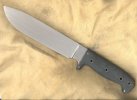- Joined
- Sep 28, 2003
- Messages
- 1,235
Ok, here's what I want to know: If you could have the perfect FIXED BLADE knife - one that you would be proud to carry, is practical, will have ago at most of the tasks you throw at it, but looks good enough to put in the display cabinet at the end of the day, what would you go for?
I'll be fairly specific in the areas to be defined as follows:
1) Forged or Stock Removal?
2) Grind? Flat, Convex, Hollow, Sabre
3) Plain or Patternweld/Damascus?
4) Steel(s) used for Blade?
5) Blade length?
6) Blade profile? (eg. Spearpoint, Top clip,drop point, bellied, recurve...., swedge)
7) Handle material
8) Hidden tang or full/mortise?
9) Guard - Double, single or asymmetrical?
10) Finish: Field Grade (plain and simple), Collector (some work/tooling on fittings) Invesment ( worked, engraved, precious embellishments)
11) Overall Length?
12 & 13) Open - to add one or two specific design points not covered, or most important to you.
14) What would you class your primary interest in knives as being: User, Collector, Maker - or combination.
Over to you guys - in the meantime, I'll put my spec together and post later.
Cheers,
Stephen
I'll be fairly specific in the areas to be defined as follows:
1) Forged or Stock Removal?
2) Grind? Flat, Convex, Hollow, Sabre
3) Plain or Patternweld/Damascus?
4) Steel(s) used for Blade?
5) Blade length?
6) Blade profile? (eg. Spearpoint, Top clip,drop point, bellied, recurve...., swedge)
7) Handle material
8) Hidden tang or full/mortise?
9) Guard - Double, single or asymmetrical?
10) Finish: Field Grade (plain and simple), Collector (some work/tooling on fittings) Invesment ( worked, engraved, precious embellishments)
11) Overall Length?
12 & 13) Open - to add one or two specific design points not covered, or most important to you.
14) What would you class your primary interest in knives as being: User, Collector, Maker - or combination.
Over to you guys - in the meantime, I'll put my spec together and post later.
Cheers,
Stephen






